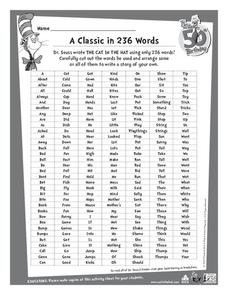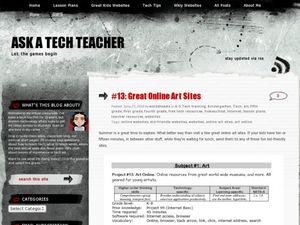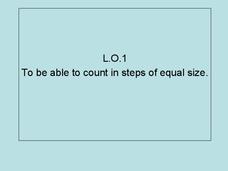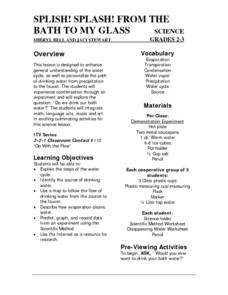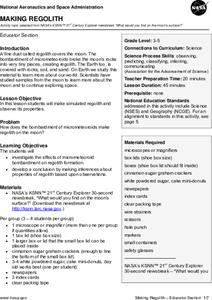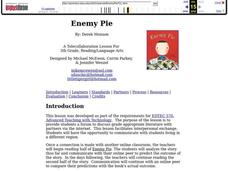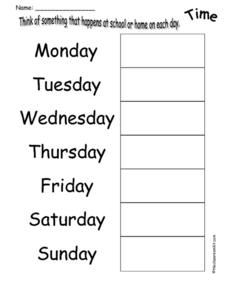Alabama Learning Exchange
Good Litter, Bad Litter
Which ones can be thrown on the ground? Discover the difference between natural litter and unhealthy trash, helping scholars by using several examples. Use the information here to give them a basic background, but also encourage prior...
K5 Learning
The Life Cycle
Studying plant, animal, or insect life cycles? Pair a science unit with a reading comprehension worksheet on life cycles. The passage touches briefly on butterfly, plant, frog, and dog life cycles before prompting readers to answer six...
Egmont
H.O.R.S.E.
Extend your lesson on Christopher Myers' H.O.R.S.E with a series of activities about basketball. After kids read the book, they match basketball terms with their definitions, find as many words as they can with the letters H, O, R,...
Seussville
A Classic in 236 Words
Get in the reading spirit on Read Across America Day while celebrating Dr. Seuss' birthday with four printable worksheet activities. Included is a word search using story character's names, a quiz to test how many Dr. Seuss titles you've...
Fluence Learning
Writing a Narrative: How Bear Lost His Tail
After reading the first, second, and third parts of "How Bear Lost His Tail", third grade writers answer questions about the story by completing a series of options, including discussion points. Then, they begin to plan a new narrative...
Arcademics
Penguin Jump
Don't jump to conclusions but to products instead. Pupils participate in an online race as penguins. Users choose the ice sheet with the correct product to the individual's multiplication prompt. The penguins jump from one product to...
Curated OER
Earth's Heavenly Treasures: Hummingbirds
Young ornithologists watch an informative video and use the Internet to gather data about the life, size, habitat, and migration of hummingbirds. The interdisciplinary lesson includes activities that target art, science, math, and...
Curated OER
Great Online Art Sites
Pupils complete an online study of art websites. In this art and technology lesson, students explore the links and try the activities to learn about art online.
Curated OER
Would You Rather?
Get to know your class by asking them what they would rather do. There are 10 different sets of "would you rather" questions sure to encourage giggles and classroom camaraderie. Tip: Have peers build memory skills by attempting to...
Curated OER
Splish! Splash! From the Bath to my Glass
An excellent lesson on the water cycle! In it, learners should gain a general understanding of the water cycle, along with how water first falls as precipitation, then ends up coming out of our faucets. This lesson nicely integrates...
Curated OER
Making Regolith
You may not be able to take a field trip to the moon, but that doesn't mean your class can't study moon rocks. Using graham crackers as the moon's bedrock and powdered donuts as micrometeorites, young scientists simulate...
Curated OER
Drawing with Wire
Students identify visual arts by examining visual models. In this art analysis lesson, students discuss the history of Keith Haring by researching information on the Internet. Students view images showing Keith Haring's work and...
Curated OER
Cutting Costs With Coupons.
Students clip coupons for food items, create a menu using those items, and add up the total savings. They correctly calculate the total amount of money that would be saved if they used the coupons.
Curated OER
Get in Shape with Geometry
Using geoboards, computer programs, and hands-on manipulative materials, elementary schoolers engage in a study of two and three-dimensional geometric shapes. This lesson is chock full of good teaching ideas on the subject, and the...
Curated OER
Holidays Around the World
Students explore how different holiday traditions are celebrated around the world. Scholars write a paper describing how they celebrate their own favorite holiday. Email partners, from different states and countries, share their...
Curated OER
Enemy Pie
Third graders pair up with a partner via an online classroom. They analyze half of the story "Enemy Pie" and communicate with their online peer to predict the outcome of the story.
Curated OER
Children's Literature Across the Curriculum Ideas-How Dogs Really Work!
Learners read How Dogs Really Work! by Alan Snow. They complete a variety of cross-curricular activities surrounding the study of dogs as pets. Included are reading, art, math, science, writing, social studies, and library connections.
Curated OER
We Love to Read Bulletin Board
Young artists create a bulletin board based on books they have read. They complete a book report and share the information with the class, and use different types of technology to help finish the board.
Curated OER
Crayon Resist
Kids usually love crayon resist projects. It is so fascinating for them to see how the dark paint accentuates and resists the waxy crayon. Here are instructions for executing a crayon resist project of your own. Tip: Make the project fit...
Classroom Kit
Think of Something that Happens at School or Home on Each Day
Record your weekly schedule with a worksheet. Next to each day of the week, write down something that happened that day, either at home or at school.
SMART Project
Shop with Us at Whelan School
Third graders use their math and research skills to create and manage a classroom/school store. They use a computer to manage, organize and access information. They practice pricing products, computing sales, counting money and...
Curated OER
Once Upon A Math Story
Learners write a math story. In this math operations and writing lesson, students work in small groups to brainstorm ideas for a math story, write a rough draft, revise their story, edit their story and add clip art. Learners...
Curated OER
Numbers in Art
Students choose a number from one to twelve and tell a number story about it. They listen to the teacher read "Numbers in Art" by Lucy Micklethwait. Students choose three numbers from one to twelve and view works of art while looking for...
Fluence Learning
Writing an Opinion: Buddies that Bark or Purr-fect Pets?
Which animal is best for you—a dog or cat? Why? Engage third graders in an opinion writing assessment that prompts them to read facts about both pets, and then write and decide which pet is best for them.



